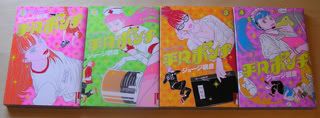
Heibon Ponch (平凡ポンチ)
by George Asakura (ジョージ朝倉)
published in Ikki (Shogakukan)
4 volumes (2003-2005)
Amazon.jp
Don't be misled by that pen name; George Asakura is, in fact, a woman. For a manga magazine, Ikki has, I'm sure, an interesting readership cross-section. While every magazine naturally has some combination of readers from both genders, in general the target audience is solidly in one camp. Even Weekly Shonen Jump, which has a surprisingly large female readership (though this could be simply because of the mainstream visibility of it), has very clear male values at the core of its philosophy: competition, effort, victory. Ikki, however, seems to aim for as many demographics as possible. In addition to literary and character-drama authors that aren't confined by a gender-specific genre (Daisuke Igarashi, Iou Kuroda, Taiyo Matsumoto, Yoko Nihonbashi, Natsume Ono), the more target-specific output runs the gamut from manly violent/sci-fi fare (Dorohedoro, Jiro Matsumoto's Freesia, Mohiro Kitoh's Bokurano) to female-created and/or oriented series (Hisae Iwaoka, Sakumi Yoshino's Period, and the brand-new BL comic Seishun Sobat). George Asakura's Heibon Ponch seems to find itself right at home in this environment by combining elements of several different styles into a highly unorthodox pastiche.
While I haven't read any of Asakura's other works, a quick browsing of the covers and summaries on her official site would suggest that she's done her share of shojo material. One glance at Heibon Punch is enough to dispel any notion of it being a typical girl-meets-prince fantasy, however. Aki Mashima is an overweight 30-year-old movie director with acne, who also happens to be a borderline lolicon with an irrational fear of large breasts. Mika Wanibuchi is an aggressively ambitious actress with an acute shortcoming in the mammary area, and an obsession with getting a pair of jugs that would make Pamela Anderson jealous. Shortly after their first meeting, Mika murders a famous busty idol, and Mashima decides to go on the run with her, filming their life on the lam. As if this set-up wasn't bizarre enough, Asakura adds more twists. Mashima is attracted to Mika's prepubescent figure, a figure which she despises. She is attracted to his fat, pimply look, but whenever Mashima grows too fond of her, his looks change overnight to a handsome, svelte version of himself, a transformation which is barely questioned by the characters and explained away as "the power of love." This good-looking version, of course, repels Mika. In addition to this "magical" transformation, a large part of the story revolves around the mythical "Village of Big Breasts," a sort of combination between an El Dorado of the male libido and a casino bus tour for senior citizens.
As you can see, Asakura is truly working with fire here. The manga walks a razor-thin line between the viciously funny and surreal gag context and the incendiary, violent romance between the two main characters. Any and every possible concept to complicate the relationship is implemented with abandon. Mashima is torn between heightening the brilliance of his road movie with Mika and thus regaining his prestige as a director, and his romantic feelings for her, and she too must balance her relationship with him with the sole-encompassing act of playing her "role" in his movie, a step on her stairway to fame. Whenever the sparks get too close, the fact that each of them desires to be what the other despises pushes them apart. Asakura has an expert grasp of the high-level adult romance at play in this love/hate relationship, and she utilizes this expertise with the velocity of a rocket. As fascinating as it can be, the extremely unpredictable and complex romance is often bewildering and incomprehensible to me, though it seems clear that in the hyper-stylized, extreme relationship setting Asakura depicts, reader identification with the characters is perhaps not the number one priority.
In addition to unorthodox setting, Asakura's art seems to fall inbetween the stereotypes for gender-specified genres. Her characters have an unmistakable shoujo/josei cast to them, but the use of tone-as-background and the general practice of ignoring background settings altogether, so prevalent in mundane shoujo series, is entirely absent here. There is plenty of emphasis on the relationship of character to background within her composition, and enough detail is paid to the locations to make their presence felt. This, in conjunction with several content topics more weighted on the male end of the gender spectrum -- an abundance of large, exposed breasts, murder scenes -- makes for a finished product that contains elements of both male- and female-oriented manga styles.
1 comment:
I didn't like what I read of A Perfect Day for Love Letters, and what I've seen of Asakura's other work hasn't interested me much, either. But your description of Heibon Ponch is very intriguing; I may pick up the first volume.
Post a Comment